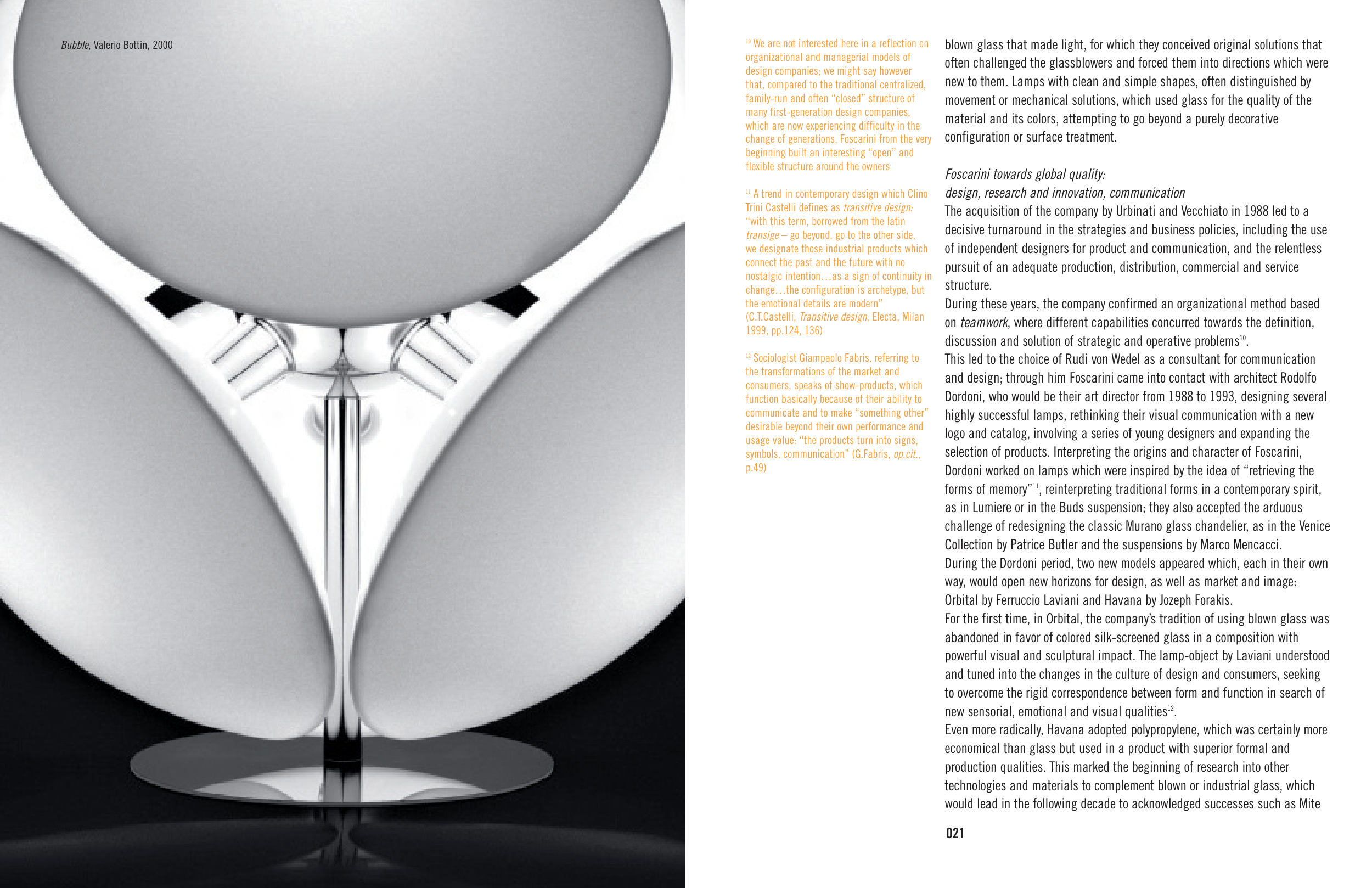021
Bubble, Valerio Bottin, 2000
blown glass that made light, for which they conceived original solutions that
often challenged the glassblowers and forced them into directions which were
new to them. Lamps with clean and simple shapes, often distinguished by
movement or mechanical solutions, which used glass for the quality of the
material and its colors, attempting to go beyond a purely decorative
configuration or surface treatment.
Foscarini towards global quality:
design, research and innovation, communication
The acquisition of the company by Urbinati and Vecchiato in 1988 led to a
decisive turnaround in the strategies and business policies, including the use
of independent designers for product and communication, and the relentless
pursuit of an adequate production, distribution, commercial and service
structure.
During these years, the company confirmed an organizational method based
on teamwork, where different capabilities concurred towards the definition,
discussion and solution of strategic and operative problems10.
This led to the choice of Rudi von Wedel as a consultant for communication
and design; through him Foscarini came into contact with architect Rodolfo
Dordoni, who would be their art director from 1988 to 1993, designing several
highly successful lamps, rethinking their visual communication with a new
logo and catalog, involving a series of young designers and expanding the
selection of products. Interpreting the origins and character of Foscarini,
Dordoni worked on lamps which were inspired by the idea of “retrieving the
forms of memory”11, reinterpreting traditional forms in a contemporary spirit,
as in Lumiere or in the Buds suspension; they also accepted the arduous
challenge of redesigning the classic Murano glass chandelier, as in the Venice
Collection by Patrice Butler and the suspensions by Marco Mencacci.
During the Dordoni period, two new models appeared which, each in their own
way, would open new horizons for design, as well as market and image:
Orbital by Ferruccio Laviani and Havana by Jozeph Forakis.
For the first time, in Orbital, the company’s tradition of using blown glass was
abandoned in favor of colored silk-screened glass in a composition with
powerful visual and sculptural impact. The lamp-object by Laviani understood
and tuned into the changes in the culture of design and consumers, seeking
to overcome the rigid correspondence between form and function in search of
new sensorial, emotional and visual qualities12.
Even more radically, Havana adopted polypropylene, which was certainly more
economical than glass but used in a product with superior formal and
production qualities. This marked the beginning of research into other
technologies and materials to complement blown or industrial glass, which
would lead in the following decade to acknowledged successes such as Mite
10 We are not interested here in a reflection on
organizational and managerial models of
design companies; we might say however
that, compared to the traditional centralized,
family-run and often “closed” structure of
many first-generation design companies,
which are now experiencing difficulty in the
change of generations, Foscarini from the very
beginning built an interesting “open” and
flexible structure around the owners
11 A trend in contemporary design which Clino
Trini Castelli defines as transitive design:
“with this term, borrowed from the latin
transige – go beyond, go to the other side,
we designate those industrial products which
connect the past and the future with no
nostalgic intention…as a sign of continuity in
change…the configuration is archetype, but
the emotional details are modern”
(C.T.Castelli, Transitive design, Electa, Milan
1999, pp.124, 136)
12 Sociologist Giampaolo Fabris, referring to
the transformations of the market and
consumers, speaks of show-products, which
function basically because of their ability to
communicate and to make “something other”
desirable beyond their own performance and
usage value: “the products turn into signs,
symbols, communication” (G.Fabris, op.cit.,
p.49)


